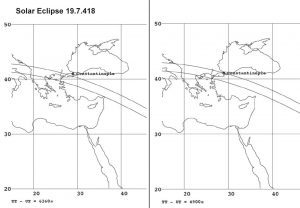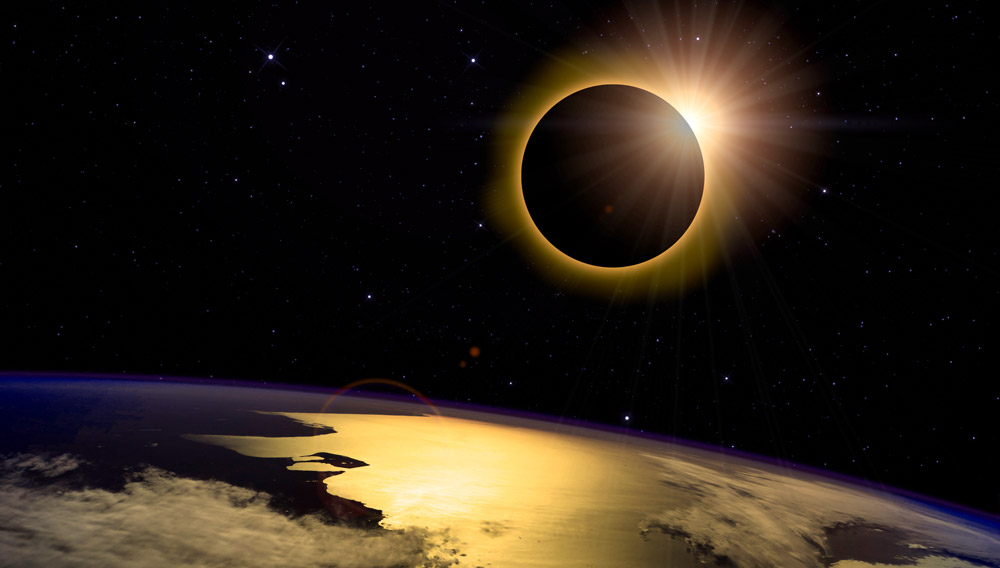Earth’s changing rotation: Historical records of solar eclipses shed new light on how different the Earth’s rotation has been over the past few centuries. According to this, about 1,600 years ago our planet was spinning a little faster than expected, while 1,400 years ago the Earth’s rotation was slower than current models suggest. Evidence for this is given by the places and times when Byzantine witnesses were able to observe a total solar eclipse.
Our planet’s rotation determines the pace of our time measurement and the rhythm of the next day: a day lasts 86,400 seconds—that’s how long it takes the Earth to rotate—at least in theory. In practice, the Earth’s rotation changes throughout the year, due to tidal forces, snowmelt and other changes in the gravitational field. In order to adjust the world time of these fluctuations, as required, in a few years leap seconds added or subtracted.
In 2020, for example, measurements discovered one acceleration From the Earth’s rotation – the days were 1.46 milliseconds shorter than the target. 2021 is slower again afterbut it’s still slightly above the guideline.
What does a solar eclipse reveal about the Earth’s rotation?
But what did this look like in previous centuries? Modern methods of measuring the Earth’s rotation using telescopes and laser gauges It has only existed since modern times. When reconstructing the Earth’s rotation in past times, scientists rely on indirect indicators. The most important of which is a solar eclipse. In such an eclipse, the solar eclipse takes place only for a few minutes, and the total eclipse – the path of totality – is visible only in a narrow spatial path on the Earth’s surface.
This is exactly what gives researchers a chance to constrain the Earth’s rotation based on historical records of the timing and location of past eclipses. With the help of models, it is possible to determine where and when a solar eclipse will occur before – provided that the Earth rotates according to plan. But if historical traditions show deviations, it reveals that the Earth was spinning faster or slower than it should.
Searching for traces in the Byzantine chronicles
For their study, Japanese astronomers led by Hisashi Hayakawa of Nagoya University evaluated historical records of five solar eclipses in the period from the fourth to the seventh centuries—a time when the Earth’s rotation can only be determined roughly until now. The team collected and analyzed texts from the Byzantine Empire, which at that time covered the entire eastern Mediterranean. Specifically, they looked for indications of the eclipse that should be visible in this region in the years 346, 418, 484, 601 and 693.
The researchers described their approach as “for each case, we analyzed historical source tests to identify the most reliable reports.” “From these documents, we extracted the reported eclipse times and locations, checked the aggregate against descriptions of stars visible during the eclipse, and matched the observational data with models.”

The data shows deviations from the model
In fact, the team was able to find enough descriptions of all five solar eclipses to be able to infer the period of Earth’s rotation at that time. Co-author Koji Murata of the University of Tsukuba says.
For example, a historical test from the fifth century describes that on July 19, 418 Constantinople saw stars in the sky in broad daylight. So the city should be in the way of college during this solar eclipse. However, based on the earlier model of Earth’s rotation at the time, Constantinople was outside the path of the eclipse, astronomers explain. So the form may need to be modified.
“This new data improves our understanding of the changing rotation of our Earth in previous centuries,” Hayakawa and his team wrote. “They also provide information on geophysical backgrounds such as long-term variability in sea level, global ice volume, and core-mantle coupling.” All of these factors can affect the Earth’s rotation. (Publication of the Astronomical Society of the Pacific, 2022; doi: 10.1088/1538-3873/ac6b56)
Source: University of Tsukuba

“Total coffee aficionado. Travel buff. Music ninja. Bacon nerd. Beeraholic.”







More Stories
Researchers detect extremely high-energy gamma rays
Anxiety disorders in old age increase the risk of dementia
Researchers are particularly fascinated by these exoplanets.